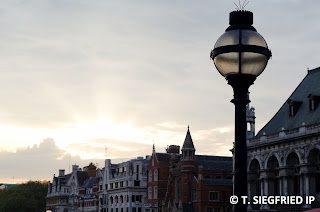I took some street screens in London. I notice that I seems to like building lining up and form a diagonal line across the frame and tunnel with high degree of symmetry. I took couple more shots than just daylight, shade and auto just to see the effect. The temperature reading is taken in Lightroom.
The first image is taken on an overcast day with interval of sunlight. One can see the sun light shines on some of the building while the sky is covered with cloud. Auto WB reading is closest to the daylight. The difference between shade and daylight is very small, but if we alternating two images on light room, the daylight WB gives very slightly more blue tone on the cloud. I have to empathize that it is very slightly, hardly noticible.
Auto WB (5150 K)
Shade WB (6000K)
Fluorescent (6850K)
Daylight WB (5200 K)
The second image is taken at around sunset. It is also overcast with sun is near the horizon. Auto WB is still closet to daylight instead of shade.
Auto WB (5150K)
Shade WB (6000 K)
Daylight WB (5200 K)
Fluorescent WB (6850 K)
The last image is taken on a subway. In this case, Auto WB is closest to Tungsten.
Auto WB (3550 K)
Flash WB (6600 K)
Fluorescent (6850K)
Daylight WB (5200 K)
Tungsten (3000K)
For the situation I have picked, Auto WB seems to be performing quite well. But then, I am not entire sure what is the difference visually when daily WB and shade WB are only 800K difference. For all three examples I have chosen, the difference is hardly noticable.















No comments:
Post a Comment